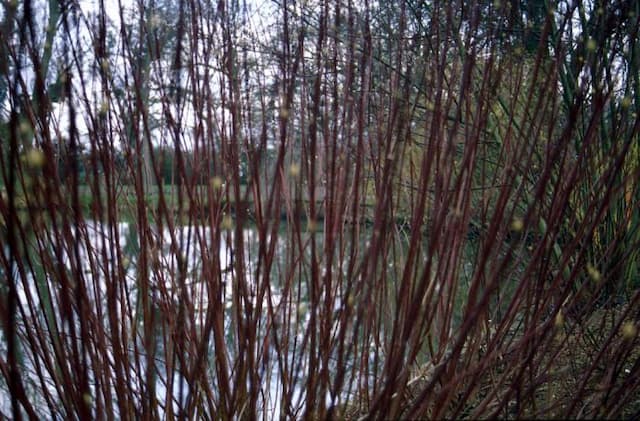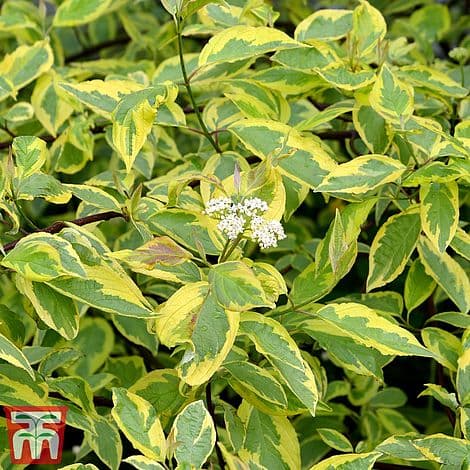Tatarian Dogwood Cornus alba 'Cream Cracker' (PBR) (v)

ABOUT
Cornus alba 'Cream Cracker', commonly known as the red-barked dogwood, is a visually striking shrub characterized by its attractive foliage and stems. The leaves of this cultivar usually display a variegated pattern, with creamy-white edges that beautifully contrast against the green center. As the season transitions into autumn, the foliage takes on warm red and purple tones before eventually falling, revealing the plant’s striking feature: its vibrant red stems. These stems provide a stark and captivating visual interest in the wintry garden landscape. During the spring, the red-barked dogwood produces clusters of small, white flowers that add to the plant's ornamental charm. Following the flowering period, it sometimes bears small, bluish-white berries that can attract birds and wildlife. The textured bark, combined with the red stem coloration and changing leaf colors, contributes to a display of year-round interest. The red-barked dogwood 'Cream Cracker' is known for its hardiness and its ability to thrive in a variety of soil types, which makes it a popular choice for gardeners looking to add a splash of color to their outdoor spaces. While adaptable and resilient, it also benefits from occasional pruning, which helps to maintain the vivid color of the new stems that emerge after cutting back the older ones. This shrub is ideal for adding a bold statement in mixed borders, as a standalone specimen, or in group plantings where its unique appearance can be admired throughout the seasons.
About this plant
 Names
NamesFamily
Cornaceae.
Synonyms
Siberian Dogwood, White Dogwood, Red-barked Dogwood, Tatarian Dogwood.
Common names
Cornus alba 'Cream Cracker' (PBR) (v)
 Toxicity
ToxicityTo humans
The common name for Cornus alba 'Cream Cracker' is Tatarian dogwood. There is no significant evidence to suggest that Tatarian dogwood is highly toxic to humans. However, as with many plants, certain parts may cause mild stomach upset if ingested. If large quantities of plant material are consumed, symptoms might include nausea, vomiting, or diarrhea. It is always advisable to avoid eating ornamental plants due to potential individual sensitivities or the presence of plant parts that may be irritating to the digestive system.
To pets
The common name for Cornus alba 'Cream Cracker' is Tatarian dogwood. This plant is generally considered to have a low level of toxicity for pets. It is not commonly known to be poisonous if pets chew on or ingest parts of it. However, some individuals may have a sensitivity that could result in mild gastrointestinal upset, including symptoms such as vomiting or diarrhea. It is always wise to monitor your pets around ornamental plants and discourage them from chewing on any plant material to prevent any potential adverse reactions.
 Characteristics
CharacteristicsLife cycle
Perennials
Foliage type
Deciduous
Color of leaves
Variegated
Flower color
White
Height
6 feet (1.8 meters)
Spread
5 feet (1.5 meters)
Plant type
Shrub
Hardiness zones
3
Native area
Asia
Benefits
 General Benefits
General Benefits- Ornamental Appeal: Adds visual interest to gardens with its variegated foliage and white to cream-edge leaves.
- Seasonal Color: Offers year-round interest with white flowers in spring and berries in summer, while leaves turn red-purple in the fall.
- Low Maintenance: Requires minimal care once established, making it suitable for various landscape settings.
- Hardy Nature: Thrives in a wide range of climates and can tolerate cold temperatures, making it versatile for different regions.
- Wildlife Attraction: Berries attract birds during the summer and fall, providing a natural source of food for wildlife.
- Erosion Control: Can be used on slopes or areas prone to erosion, helping to stabilize the soil with its root system.
- Privacy and Screening: Useful for creating hedges or screening views, offering privacy to yards and gardens.
- Drought Tolerance: Once established, has the ability to withstand periods of low rainfall, reducing the need for frequent watering.
- Adaptable to Soils: Grows in a variety of soil types, from sandy to clay, provided they are well-drained.
- Suitable for Mixed Planting: Works well when planted in mixed borders alongside other shrubs and perennials.
 Medical Properties
Medical PropertiesThis plant is not used for medical purposes.
 Air-purifying Qualities
Air-purifying QualitiesThis plant is not specifically known for air purifying qualities.
 Other Uses
Other Uses- Wildlife Habitat: The bushy structure of Cornus alba provides shelter and nesting sites for birds and other wildlife, making it an ideal choice for nature-friendly gardens.
- Winter Interest: With its brightly colored stems, Cornus alba 'Cream Cracker' can be used to add color to an otherwise barren winter landscape.
- Garden Sculpture: By training or pruning, Cornus alba can be shaped into living sculptures, adding a unique artistic element to garden design.
- Natural Fencing: When planted in a row, Cornus alba can act as an informal hedge or living fence, providing a natural barrier that changes with the seasons.
- Erosion Control: The root system of Cornus alba can help stabilize slopes and riverbanks, controlling soil erosion.
- Photography Backdrop: The striking stems and foliage can serve as an ideal backdrop for photography, especially during autumn and winter months.
- Dye Production: The bark and leaves of Cornus alba can be used to produce natural dyes for textiles or crafts.
- Winter Bouquets: Branches can be harvested and used in floral arrangements or Winter bouquets, offering a splash of color and texture.
- Educational Tool: Cornus alba can be used in educational settings to teach about plant growth, seasonal changes, and botany.
- Seasonal Screen: Planting Cornus alba in strategic areas of a garden can provide a seasonal screen, offering privacy during the times of year when the plant is in full leaf.
Interesting Facts
 Feng Shui
Feng ShuiThe Red Twig Dogwood is not used in Feng Shui practice.
 Zodiac Sign Compitability
Zodiac Sign CompitabilityThe Red Twig Dogwood is not used in astrology practice.
 Plant Symbolism
Plant Symbolism- Stability and hope: As a dogwood variety, Cornus alba symbolizes stability and hope, reflecting the plant's hardiness and the resilience it shows throughout the seasons.
- Purity and innocence: The white flowers of the dogwood are often associated with purity and innocence, traits that can be reflected in the light-colored foliage and stems of the 'Cream Cracker' variety.
- Faith and durability: In Christian symbolism, the dogwood is associated with faith and endurance, owing to the legend that it was the wood used for the crucifix, which then made the tree smaller and twistier to prevent it being used for the same purpose again.
- Rebirth and new beginnings: The dogwood's spring blossoms are seen as a sign of rebirth and the start of new beginnings, an appropriate symbol as the 'Cream Cracker' bursts into life with fresh, cream-edged leaves each year.
- Protection and safety: Historically, native tribes used various parts of dogwood trees for protection, infusing symbolism of safety and safeguarding within the species to which Cornus alba 'Cream Cracker' belongs.
 Water
WaterThe Red Twig Dogwood, commonly known as Cornus alba 'Cream Cracker', should be watered thoroughly to establish deep and extensive root systems. During the first growing season, water regularly to maintain uniformly moist soil, providing about 1-2 inches of water per week. Once established, they are more drought tolerant and will need less frequent watering. During dry spells in the growing season, water them deeply every 2-3 weeks. It's important to avoid overwatering, making sure the plant is in well-draining soil to prevent water logging.
 Light
LightRed Twig Dogwood prefers full sun to partial shade to thrive. The ideal spot would allow the plant to receive at least 4 hours of direct sunlight daily, but it can tolerate some light shade. Avoid placing it in deep shade as this can impact its vibrant stem color and overall health.
 Temperature
TemperatureThe Red Twig Dogwood is hardy and can withstand a broad range of temperatures. It can survive minimum winter temperatures down to about -30°F and is suited for USDA zones 2 through 7. The ideal growing temperatures for this plant range from 60°F to 75°F during the growing season. However, it is quite adaptable and can handle temperature fluctuations outside of this range.
 Pruning
PruningRed Twig Dogwood should be pruned to maintain its shape and encourage vibrant stem color, which is most pronounced on new growth. Pruning is best done in late winter or early spring before the leaves emerge, removing about a third of the oldest stems at the base annually. Additionally, occasional thinning of the plant can help to improve air circulation and promote healthier growth.
 Cleaning
CleaningAs needed
 Soil
SoilThe best soil mix for the Tatarian dogwood 'Cream Cracker' is a well-draining, loamy soil enriched with organic matter. This plant prefers a slightly acidic to neutral pH level, ranging from about 5.5 to 7.5.
 Repotting
RepottingTatarian dogwood 'Cream Cracker' typically does not require frequent repotting as it is often grown as an outdoor shrub. However, if grown in containers, repot every 2-3 years to refresh soil and accommodate root growth.
 Humidity & Misting
Humidity & MistingTatarian dogwood 'Cream Cracker' is adaptable to a wide range of humidity levels. It prefers average garden conditions and does not require any special humidity requirements.
 Suitable locations
Suitable locationsIndoor
Provide bright light, cool temps, and water sparingly.
Outdoor
Plant in moist soil, full sun to part shade.
Hardiness zone
2-7 USDA
 Life cycle
Life cycleCornus alba 'Cream Cracker', also known as the Siberian dogwood 'Cream Cracker', starts its life as a seed, requiring stratification to break dormancy before germination. Once germinated, the seedling stage begins, involving the development of roots and the first set of true leaves, establishing the plant. As it enters the vegetative stage, the plant experiences rapid growth, producing stems, leaves, and a robust root system, with variegated foliage being a distinctive feature of this cultivar. The plant then matures to the flowering stage, showcasing small white flowers in the late spring or early summer, followed by the development of white or bluish-white berries in the fall. During the autumn, the foliage typically turns a vibrant red or purple before leaf fall. Through the winter, Cornus alba 'Cream Cracker' reveals its bright red stems, providing striking color in the landscape, completing its annual cycle before the process restarts in the spring.
 Propogation
PropogationPropogation time
Late Winter to Early Spring
Propogation: Cornus alba 'Cream Cracker', commonly known as the variegated redtwig dogwood, is commonly propagated through hardwood cuttings. The optimal time for taking hardwood cuttings is during the plant's dormant period, usually in late fall to winter. To propagate, one would select a healthy, mature stem and cut a section that is about 6 to 8 inches (15 to 20 cm) long. Each cutting should have at least two sets of buds. After making the cut, the bottom end of the cutting is dipped in rooting hormone to encourage root growth and then planted in a pot with well-draining soil, ensuring at least one set of buds is above the soil surface. The pot needs to be kept in a cool but frost-free location until the cuttings have rooted, which typically occurs by the following spring. It's important to maintain consistent moisture during this time, but not to the point of waterlogging, which could cause the cuttings to rot.









